The Hottest Hit On The Planet:
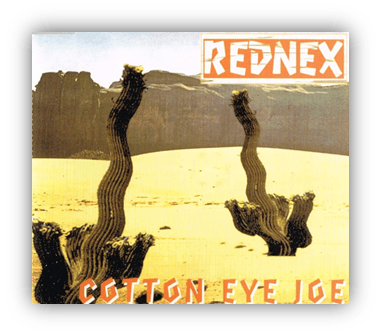
“Cotton Eye Joe” by Rednex
It was a Eurodance classic more than a hundred years in the making. Way back in 1910:
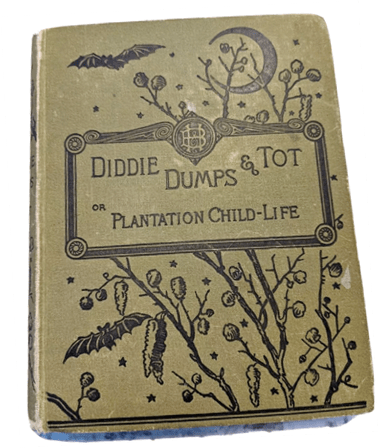
Smack bang in the middle of a book titled Diddie, Dumps, and Tot, Or, Plantation Child Life…
….the fond recollections of an Alabama writer feeling nostalgic for a simpler time when her family owned lots of slaves…
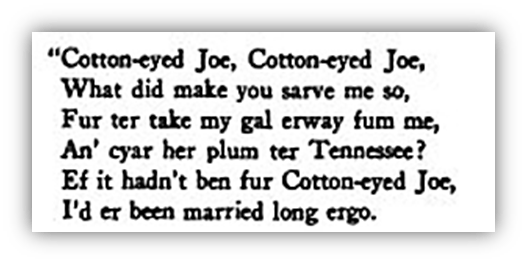
Author, Louise Clarke Pyrnelle, dropped the lyrics to “Cotton Eye Joe.”
In the Diddie, Dumps, and Tot universe, “Cotton Eye Joe” was one of the slaves’ favourite songs. And fair enough, it’s a catchy song.
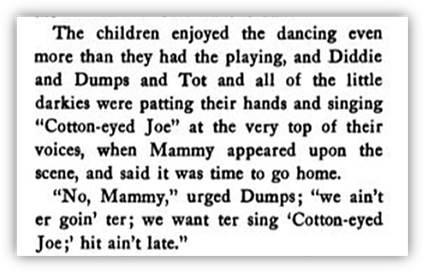
The Swedish producer boffins behind 90s Eurodance hitmakers Rednex, I feel confident in assuming, had never read Diddie, Dumps, and Tot.nd fair enough, it’s a catchy song.
Now… on page 2 of Diddie, Dumps, and Tot there is a note:
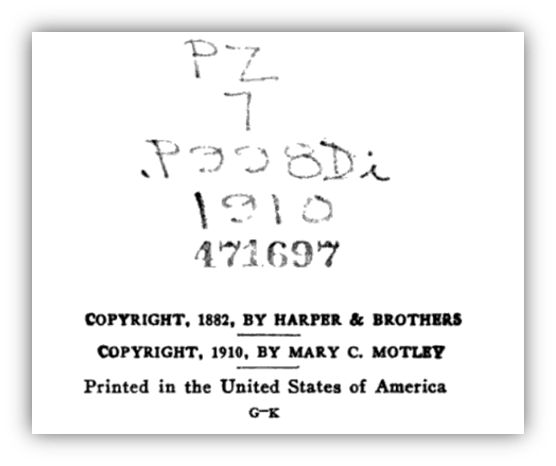
“Copyright 1882, Harpers & Brothers.”
This suggests that “Cotton Eye Joe” was copyrighted by Harper & Brothers in 1882. This doesn’t mean that anyone in the offices of Harper & Brothers actually wrote “Cotton Eye Joe.” They just nabbed the copyright to it. That seemed to happen a lot back then.
“Cotton Eye Joe” was also mentioned in 1884 – no lyrics this time – in a short story inside the Fireman’s Magazine Of The Brotherhood Of Locomotive Firemen of The United States and Canadas (there was more than one Canada back then?), in which “Cotton Eye Joe” is the only song the local fiddler knows. He probably played it something like this, the first known recording of “Cotton Eye Joe” by Dykes Magic City Trio, a fair few decades later, in 1927.
The Swedish producer boffins behind Rednex had never listened to Dykes Magic City Trio, either.
Where “Cotton Eye Joe” came from no-one knows. They were definitely singing it on the plantations of Louisiana and Texas before the Civil War. And it was definitely popular enough that it might be the only song that a local fiddler would know a few decades later.
“Cotton Eye Joe” didn’t go anywhere. It became something of a fiddler’s standard, covered many, many, multiple times.
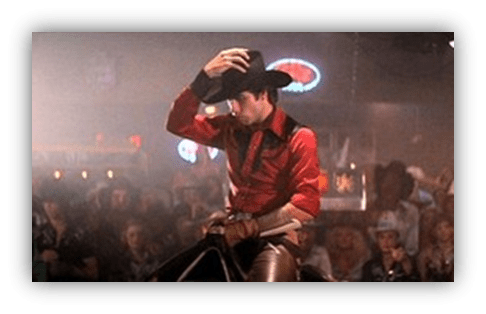
You can hear it in the background of a bar scene in Urban Cowboy.
It even crossed the Atlantic Ocean, being recorded by aging Irish folk band The Chieftains – some say the melody came from Ireland to begin with, so that seems fair – on a 1992 album in which they collaborated with a bunch of American country stars. In this case they got Ricky Skaggs, who doesn’t really do much; just sings the chorus twice, and plucks away a bit on a mandolin.
This is the version that the Swedish studio boffins behind Rednex heard.
Since Ricky only sang the chorus, the studio boffins had to come up with some verses. Not having any idea about Diddie, Dumps, and Tot, they also had no idea that other lyrics existed. According to Didde, Dumps, And Tot, the verses went a little something like this:
“His eyes wuz crossed, an’ his nose wuz flat,
An’ his teef wuz out, but wat uv dat?
Fur he wuz tall, an’ he wuz slim,
An’ so my gal she follered him.”
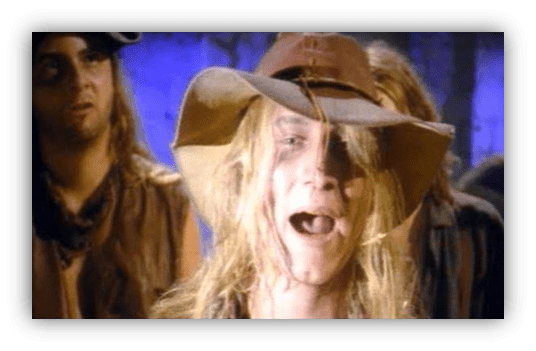
Clearly: “Cotton Eye Joe” was a man that no woman could resist.
Rednex kept to the same theme:
“He brought disaster wherever he went
The hearts of the girls was to Hell, broken, sent
They all ran away so nobody would know
And left only men ’cause of Cotton-Eye Joe”
Given that the list of plausible definitions of “cotton-eye” includes someone who has been blinded by wood alcohol, or bacterial infections such as trachoma or syphilis or glaucoma, “Cotton Eye Joe” is doing surprisingly well with the ladies.
But who were Rednex? Where – in other words – did they come from?
According to the promotional material at the time, Rednex were made up of Mary Joe, Bobby Sue, Ken Tacky, Billy Ray and Mup. You will not be surprised to learn that these were not their real names. This was not their true identity.

Rednex were the brainchild, such as it was, of three Swedish producers: Janne Ericsson, Örjan Öberg, and Pat Reiniz.
According to the Eurodance Encyclopedia, the members of Rednex belonged to a collective of creatives, united in a common mission:
“To start a hobby-project to let out ideas that could not be used in their various commercial professions. These were controversial ideas with a dirty, non-aesthetic, rough flavor, but with a general playful, partying and happy feeling”.

This suggests that Rednex were not the only “hobby-project” this collective worked on:
That there are other Swedish Eurodance novelty acts “with a dirty, rough flavour, but with a general playful, partying and happy feeling.” This is a terrifying thought.
So Janne, Örjan and Pat came up with the idea of a turning “Cotton Eye Joe” into a hardcore Eurodance party anthem. An idea presumedly stolen – although I have no evidence to back up my suspicions – from the banjo-plucking minimalist techno classic “Swamp Thing” by The Grid, which had come out a couple of months earlier. Maybe it was a coincidence. Maybe there was something in the water. Or maybe Rednex thought they’d take a good idea, and kill it.(“Swamp Thing” is a 9.)
Since turning “Cotton Eye Joe” into a hardcore Eurodance party anthem does not appear to have been particularly challenging, the trio then turned their attention to coming up with a backstory to explain what was going on.
This is the story they told the world. The official story of where Rednex came from, and how they came to be.

Pat Reiniz had taken a trip to the village of Brunkeflo, Idaho (just up the mountain path from Bumf*ck, Idaho), searching for his long-lost relatives. Imagine his surprise when he arrived and discovered that he was RELATED TO THE WHOLE ENTIRE TOWN!
Because, naturally, being horny rednecks, who had never had any contact with the outside world, they were all inbred.
They were also all hugely musically talented (that’s debatable), so Pat took the most talented of them back to Sweden to make a record. How he managed to convince them to get in a plane I can’t possibly imagine.
Living in Sweden was not without its teething problems for our poor Brunkefloians.
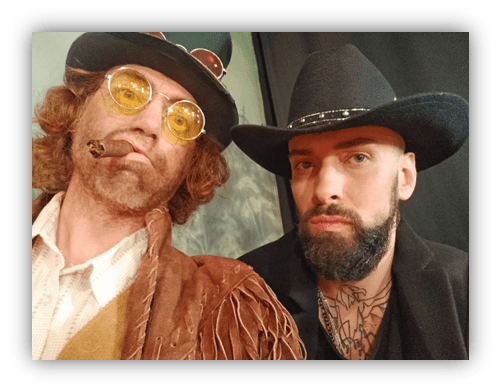
They couldn’t find any skunk to eat, for example, so they ate a dog. This was the degree of cultural sensitivity that Rednex brought to their depiction of redneck culture.
It was all made-up, obviously. But apparently it still required a Swedish newspaper to “expose’ the scandal. To uncover Rednex’s true identities. Was anybody actually shocked?
Apparently not. The expose didn’t destroy their hit-making careers, Milli Vanilli-style. They went on and they recorded an album.

They titled it “Sex & Violins”, which I’m sure they thought was hilarious.
And since it is nigh on impossible to find a Swedish 90s act without a Max Martin connection, he did some work on the power-ballad, “Wish You Were Here”, which you will be relieved to learn is not a cover of the Pink Floyd song. “Wish You Were Here” was a huge hit all across Europe. Rednex have had a surprisingly large number of huge hits all across Europe.
Rednex continue to exist. Not only has Rednex not died, it has multiplied. It has been franchised. There is now a Rednex NZ for the Antipodean market. There have been countless members over the years, each generation seemingly doubling – or even tripling – down on the dumb-assery of their stage-names. Current members include Boneduster Crock, Pervis The Palergator, and Moe Lester the Limp.
You don’t have to know any of this to hate “Cotton Eye Joe” by Rednex. But it may make it easier to justify.
“Cotton Eye Joe” is a 3.
Meanwhile, in Lesbian-Land:

It’s “I’m The Only One” by Melissa Etheridge
It was January 20th, 1993. It was at the Triangle Ball, a gay ball to celebrate Bill Clinton’s first inauguration.
Melissa Etheridge was there. k.d. lang was standing right next to her. Melissa was holding a microphone. She was telling the crowd how inspired she was with k.d., who had come out about a year before. k.d. looked well chuffed, as well she might. She gave Melissa a hug.
Then Melissa said the words she had been wanting to say for some time. She said “I’m proud to say, right now, I’m very proud to be a lesbian all my life”. k.d. jumped up and down and threw her hands in the air with joy. You have never seen somebody so happy and k.d. lang at that moment.
Melissa, as it happens, had encouraged k.d. to come out, so for Melissa to come out in front of k.d.… it was a magic moment for both of them.
That Melissa Etheridge was a lesbian wasn’t exactly news. It certainly wasn’t news to her parents back in Leavenworth, Kansas, a small, sleepy town – Leavenworth’s biggest tourist attraction? A carousel museum – a short drive from Kansas City. She’d come out to them shortly before she headed out west to California. Her father had been supportive – “Is that all?” he asked – her mother, somewhat less so, although that may have been due to catching Melissa bringing a lover home one night. She was, let’s say, rather taken by surprise.
So Melissa had dreams of leaving Leavenworth. Los Angeles was calling her.

She was going to keep on singing at the Que Sera Club, where she would be “discovered.” By Chris Blackwell at Island…

(I know, right: him again!)
Other than being a lesbian bar, the Que Sera Club wasn’t really the sort of place you’d expect to find Melissa hollering out her gritty, bluesy, rock’n’roll. Whenever Melissa wasn’t playing, the Que Sera Club was mostly a Goth bar: they had a “Kiss The Vampire” night twice a month!
The lesbians at the Que Sera Club didn’t need Melissa to come out to them – they already knew – but the general rock radio listening public was another matter.
They started speculating as soon as “Bring Me Some Water” hit.
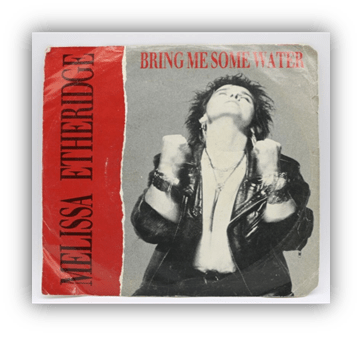
(It’s a 10, “Like The Way I Do” is pretty good too, and “Similar Features”, that’s a good one, it’s an 8…)
All three were monster-radio hits in Australia. So I’m always surprised to find that elsewhere they appear to be considered almost as obscure before-she-was-famous type songs) and turned Melissa into pretty much the only woman to get played on rock radio.
One of the reasons Melissa was played rock radio was because she sounded tough, she sounded husky. People were always mistaking her for a man. She’d call up a company – a radio station perhaps – and the receptionist would answer the phone with “yes sir, how can I help you?”
“Bring Me Some Water” was some seriously rugged Middle America heartland rock. “Bring Me Some Water” was not the sort of music typically associated with queer culture. “Bring Me Some Water” was the furthest you could possibly get from disco.
When your target demographic is rock radio listeners, coming-out was always going to be a bit of a risk, but Melissa told herself: “I always imagined if any radio station wouldn’t play me because I’m a lesbian, they probably weren’t playing me because I was a woman.”
The video for “Bring Me Some Water” was also where Melissa would meet her future partner, Julie Cypher, who, at the time, was married to Lou Diamond Philips. It says a lot about the raw sexual energy of Melissa Etheridge – and I think we can all agree that Melissa exudes raw sexual energy – that she was able to steal someone away from Lou Diamond Philips!
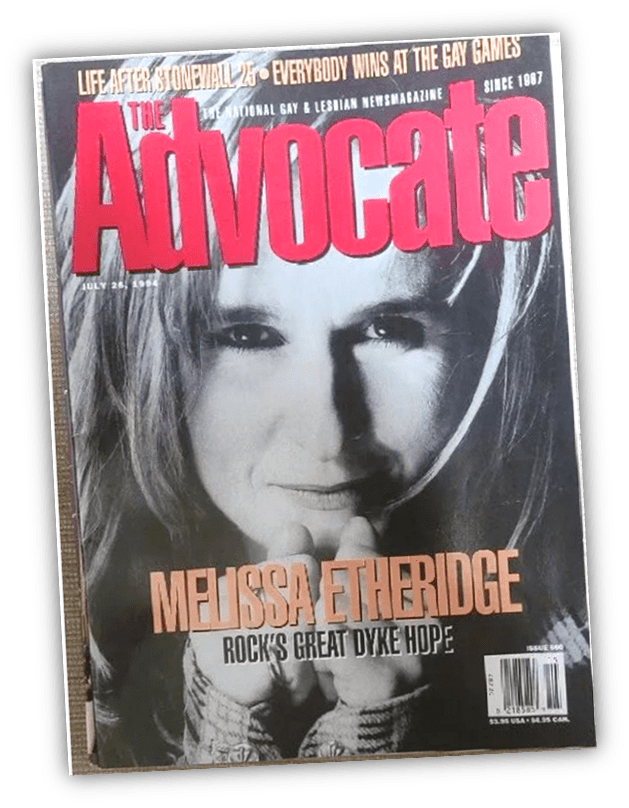
Together Melissa and Julie were interviewed by gay magazine The Advocate – the same magazine in which k.d. lang had come out a year earlier – who went with the cover-story headline “Rock’s Great Dyke Hope.”
Melissa revealed that the weirdest thing about coming out was that journalists had now started coming out to her. And then asking her to keep it a secret, because they didn’t want anyone else to know.
The Advocate interview also included this exchange, when discussing Melissa’s position in pop culture.

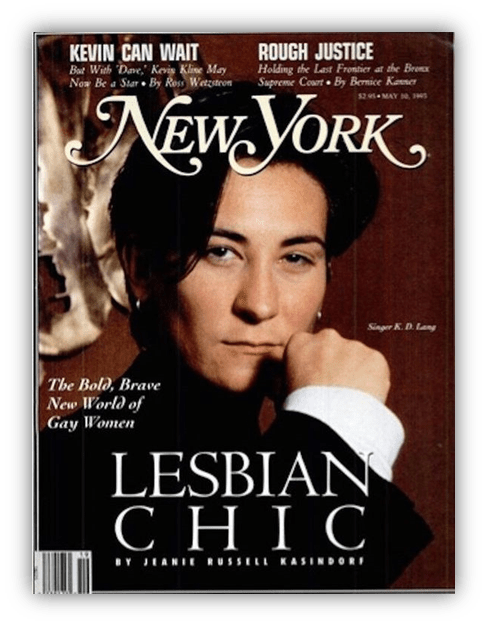
Indeed, I’m pretty sure Melissa never found herself on the front cover of both New York and Vanity Fair,
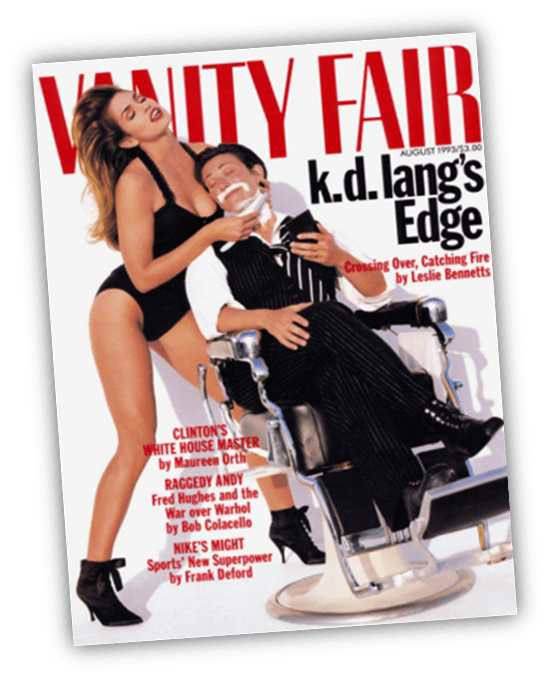
In the latter case being shaved by Cindy Crawford, like k.d. did.
Soon there would be rumours about Melissa and k.d. but also about an imaginary love-triangle between Melissa, k.d. and Martina Navratilova! “I’ve read that Martina was going out with k.d.,” Melissa told The Advocate and then she dropped k.d. for me!” Melissa, k.d. and Martina were the only famous lesbians the general public knew, so of course they must’ve been dating each other!
Everyone was talking about how lesbians were having a moment.

To give you an idea of the temper of the time, it was pretty much exactly now that Friends premiered, with a sub-plot about Ross’s wife – Carol – dumping him for another woman in the very first episode: “The One Where Monica Gets a Roommate.”
That’s where lesbianism was at on the cusp of 1994-95; somewhere between edgy next-big-thing, a punch-line, with a dash of bad old-fashioned moral panic still hanging in there.
Melissa and Julie had a son and a daughter together. Professional walrus impersonator David Crosby was the sperm donor. It turned out that David did that sort of thing a lot. Most rockstars find themselves accidentally fathers as a result of sleeping with random groupies.
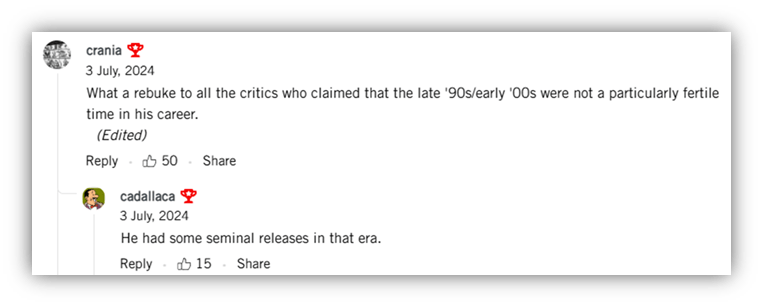
David Crosby was just a serial sperm donor, a revelation that led to one of my all-time favourite Stereogum comments:
Melissa had also been considering Brad Pitt for the role, but she got the impression that Brad would want to be a proper father, constantly popping around to throw the football. That’s not what she was looking for in a sperm donor.
In amongst all of this, Melissa released her album. And she called it Yes I Am; a statement of affirmation about, well, anything.

The album was made before Melissa came out, but at the same time it was made knowing that she would soon be coming out.
Melissa became particularly adamant that she was going to come out after one music magazine kept on misquoting her as saying “my boyfriend” all the time. Melissa knew she had to set the record straight… as it were.
“I’m The Only One” – the big hit from “Yes I Am” – is not obviously queer, but that’s mostly because Melissa doesn’t like using gendered pronouns in her lyrics. She prefers to keep them universal. Melissa sings a lot of “I” and “You” and “My” songs.
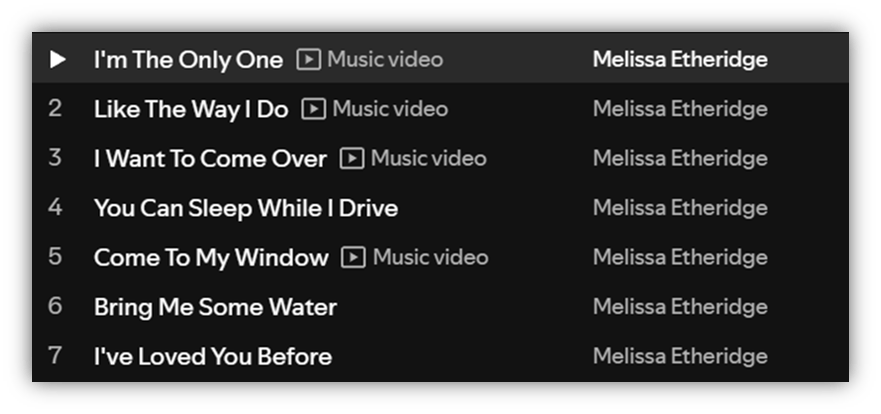
About the only lyric of “I’m The Only One” that might be interpreted as relating to her sexuality, is…
“It’s only fear that makes you run
The demons that you’re hiding from”
That line could very easily be read as dealing with the fear of coming-out, and quite possibly was supposed to. The overall impression of “I’m The Only One” however is simply a song steaming with sexuality. No particular sexuality. Just sexuality in general. You’re holding Melissa til the screaming is gone, Melissa’s drowning in desire for you etc. Melissa exudes so much sexuality on “I’m The Only One” that everyone in the video seems to want to get with everyone else in the video, partially because they’re all objectively hot, but also because of the irresistible force of Melissa’s Etheridge-ness (although it’s still the guy and the girl who get together at the end… I think… the lighting is very confusing)
At first glance “I’m The Only One” isn’t much different from the before-she-was-famous favourite “Like The Way I Do”, except that “Like The Way I Do”, despite sounding like a bulldozer, is full of uncertainty: she’s asking if she loves you like the way Melissa loves you (“Like The Way I Do” is an 8.)
On “I’m The Only One”, Melissa is more assertive; she’s knows that she’s the only one who’ll walk across the fire for you.
I’ve always had a problem with these “only one” songs, these “wait, they don’t love you like I love you” songs. These, you have to be with me because no-one else will want you songs. And there’s a lot of them. I mean, is this supposed to be a compliment? That no-one else will love me? Am I supposed to feel flattered? Is this really the pick-up line you want to go with? And you expect it to work?
Of course, if it’s Melissa, it just might.
“I’m The Only One” is an 8.
Meanwhile, in BritPop Land:

It’s “Connection” by Elastica
It’s time for another episode of the Brit-Pop soap opera.
A very special Elastica episode.
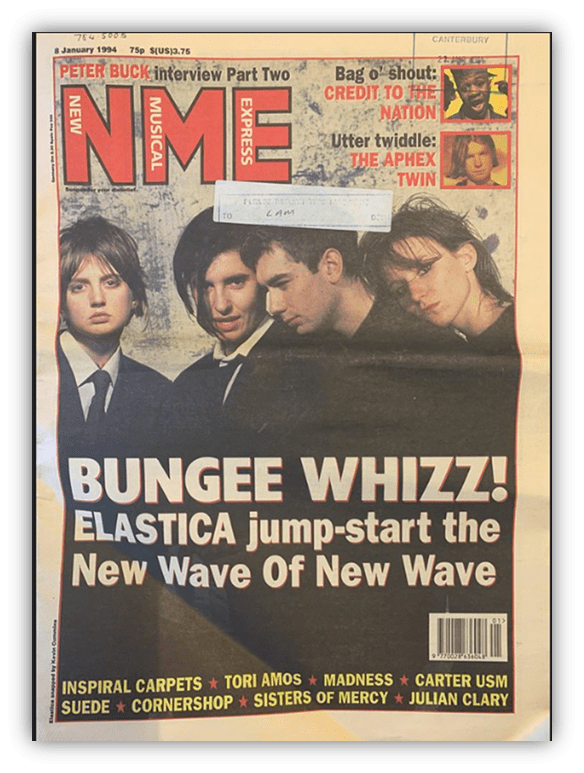
Even though, for at least one magazine cover, our heroes were dubbed the champions of a whole new musical movement: The New Wave Of New Wave! But nobody could be bothered with that mouthful, so it was back to Brit-Pop by the end of the week.
Brit-Pop was a soap-opera in which Elastica frontwomen, Justine Frischmann, may have been the central character. She was always in the middle of things. At every critical plot twist. Tying all the characters together. Coming up with probably the coolest Cool Britannia album of all!
First she dated Suede’s Brett Anderson. This was before they were famous. Before they were even called Suede. The first time she saw Brett she wondered if he was a girl, because he was wearing two ear-rings and carrying a ladies handbag.
On paper at least they were the perfect couple, because Justine was sometimes called “Sir” whenever she went shopping (this seems to be a bit of a reoccurring theme today), and they both had exactly the same hair style. She was also a member of Suede but she had to leave because (chose your favourite reason):
- (a) she was sick of playing guitar in the back of the band, or
- (b) she was hanging out with Blur too much, which felt like a betrayal in the hyper-competitive, every-band hating every-other-band, Brit-Pop ecosystem.
Soon she was dating Damon Albarn from Blur, resulting in a King and Queen of Brit Pop situation, and the bizarre spectacle of indie musos being hounded by the paparazzi. Kylie & Jason being hounded by paparazzi made sense. They were proper pop stars. But Justine and Damon? This sort of thing had never happened to Morrissey.
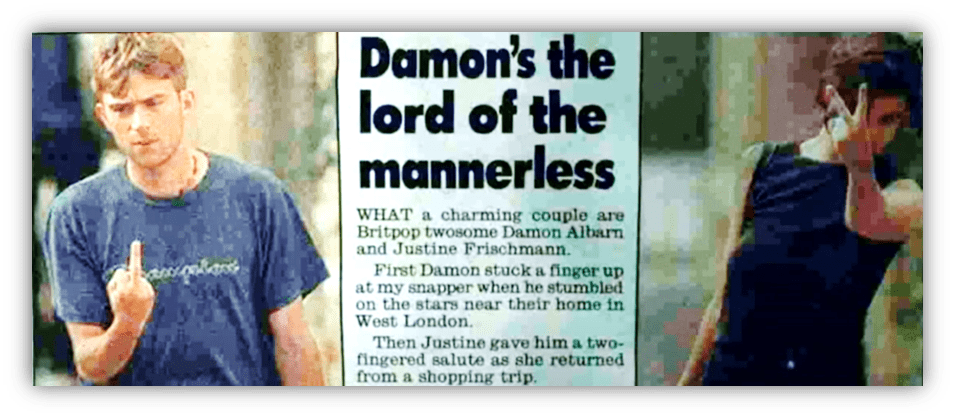

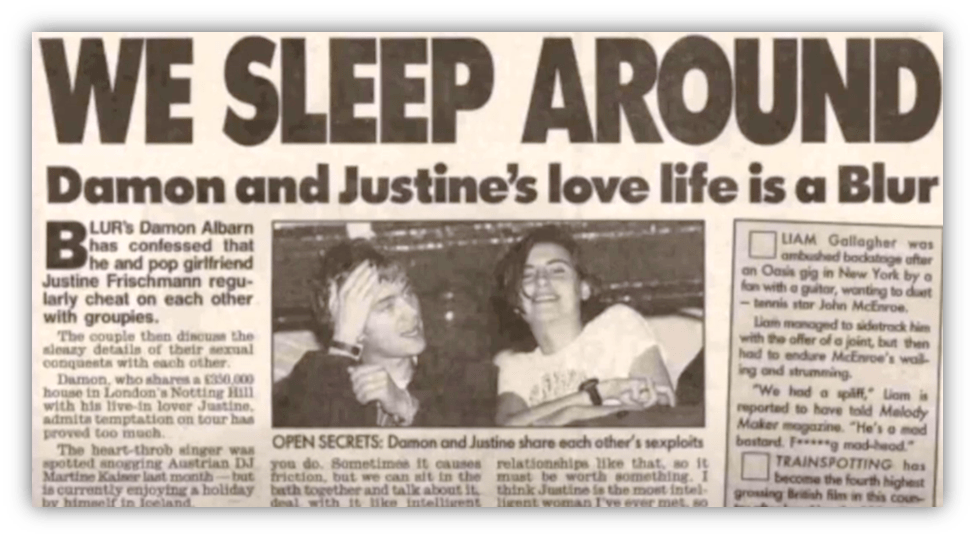
Then Liam had to go and admit that he fancied her; although that may have been primarily to wind Damon up.
“Are you gonna go for her, then?” a reporter asked.

“Nah” Liam retorted “she’s gonna go for me.”
(She didn’t.)
(Rumour has it that this, and the entire Blur vs Oasis Battle Of Brit-Pop broke out because Damon was also dating another girl that Liam was seeing. Or as Noel put it: “Liam and Damon were s****ing the same bird and there was a lot of cocaine involved.” Everything is finally starting to make sense)
In the middle of all of this, Justine formed a band. An almost-all-girl-band: it was just so hard to find a girl drummer in the 90s. After playing around with names like Spastica and Spastics Society, she finally settled on something a bit more sensible: Elastica, a band that was, for one album at least, just as good as either Oasis or Blur. Or Suede for that matter. Just as good, and very much cooler.
Elastica looked like a gang.

They looked like a bunch of kids you’d want to be mates with, but at the same time, feel a little bit wary of.
It wasn’t just because of Justine. There were other members in the band too. There was Donna Matthews. Whenever the camera drifted away from Justine, it always found itself looking at Donna instead. At her doe eyes, her pouting mouth, her short chopped up red hair, and just general tough-girl demeanour.

If you look at the cover of Elastica’s self-titled debut album, and didn’t know any better, you’d be forgiven for thinking she was the lead singer.
If you look at the cover of the “Connection” single, which is nothing but a photo of Donna pouting whilst holding a guitar, you’d feel certain of the fact…
It was about this time that Sleeper would start having hits, seemingly in order to satisfy the demand for an Elastica in which Donna was the lead singer. But it wasn’t Donna of course, it was the even more doe-eyed Louise Wener, whose presence sucked up so much of the camera’s attention that the phrase “Sleeper blokes” was invented to describe the largely-ignored male members of any band with a charismatic female singer.
Then of course there was the music. The songs.
Elastica were able to make any topic sound cool (making a cup of tea, and puttin’ a record on, on “Waking Up” for example… it’s a 9). They were able to make any topic sound sexy. “Stutter” for example, may be the sexiest song ever written about impotence (it’s a 10). Damon is said to have laughed when he heard it and ask if it was about him.
Elastica ripped off about as many old songs as Oasis, but their approach was totally different. They were less obvious for one thing; no Beatles. They were also more specific in the sounds they stole: post-punk and new wave of the late 70s. A Rolling Stone review of their album suggested they were influenced purely by Martha & The Muffins, and whilst that would have been amazing, it’s simply not the truth. Maybe the problem was length: z goes for more than three-and-a-half minutes, whereas Elastica famously liked to steal riffs from one-and-a-half minute songs like Wire’s “Three Girl Rhumba.”
The intro to “Connection” is obviously based on “Three Girl Rhumba” but it’s not the same. More importantly, it’s better. That moment when the guitars, the bass, the drums, the EVERYTHING kicks in with a Great Big “WOOAAARRRGGGHH!!!!” I’ve never been at an indie disco where that moment didn’t go off!
“Connection” is a 9.
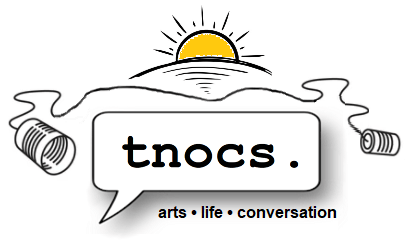
Let the author know that you liked their article with a “Green Thumb” Upvote!






Further thoughts: A lot of people are put off by all the grunting on “Connection”. All that “WOOOAAAARRRRGGGGHHH!!!!” stuff.
I understand. I’m guessing you really hate “Line Up” then, in which the “WOOOAAAARRRRGGGGHHH!!!!” of “Connection” is replaced by something more resembling the coughing up a lung. I’m really not sure what the deal is with that. (“Line Up” is an 8)
https://www.youtube.com/watch?v=g7Y7vH2XsAM
Also, since I mentioned k.d. so much, I really should give a rating to “Constant Craving”: it’s a 9.
Three favorite moments in “Constant Craving;”
-The way that the guitar solo punches in on its first note
-The mournful accordion bed that follows in the background
-The perfect pitch quality of the (presumably not auto-tuned) harmonies.
They really put in the work on the production and arrangement for this one. A solid effort.
In a column full of great turns of phrase, this is the one that got me laughing out loud at 4:30 a.m.: “Professional walrus impersonator David Crosby ….”
Wire sued Elastica despite having themselves taken and slightly modified riffs from Neu!. As above, so below.
The mid 90s were a great time for radio, but there were some selections that were overplayed to the point of oppression. Hootie and Blowfish’s first few singles were absolutely everywhere, and so were Melissa Etheridge’s.
With the passage of time, I can appreciate them, but I nevertheless still twitch when “I’m the Only One” starts. It’s not only fear that makes me run, Mel.
Just pointing out that the word dyke was referenced in two different unrelated places in the article, with two different meanings, I would assume. Strange coincidence?
I’m not from the south, but I find the whole conceit behind Rednex to be extremely offensive. Glad the song is rock bottom bad and I don’t have to apologize for liking it.
I, on the other hand, must profusely apologize…
I know some acts are franchised, like Blue Man Group. They’re anonymous characters anyway so it doesn’t matter which three guys in blue paint you’re seeing. But Rednex? I didn’t think the market would be that big.
While Elastica was touring with a temporary bass player, I managed to get a demo cassette into Justine’s hands to show off my skills. At the time though, all I had to give her was my hardcore punk from the 80s. Definitely not Cool Britannia stuff. You won’t be surprised to know I never heard from her.
Justine was a architecture student before Suede and presented a BBC series about modern design. She has retired from music and is now an artist.
https://www.justinefrischmann.net/
I know of Melissa Etheridge but I don’t think I’ve ever listened to her til now. Highest charting single in the UK reached #100. Which probably equates to roughly 100 people buying it. I’m The Only One is not the one for me. Maybe I’m in a group of 1 but I’d rather hear Cotton Eye Joe than listen to it again – and that is a statement that should not be taken as approval of Cotton Eye Joe.
She sounds like a great person and adding far more value to humanity than Rednex but I’m The Only One left me cold.
Connection may be a blatant rip off of Wire but it’s also a lot more fun than Wire. It’s only a 9 to leave room to give Stutter a 10 for its headlong rush of adrenaline.
Her sound might just not work for you. I will recommend three other tracks of hers : Nowhere to Go, I Take You With Me, and I Need to Wake Up. The latter two are from soundtracks (” Boys on the Side” and “An Inconvenient Truth, ” respectively. )